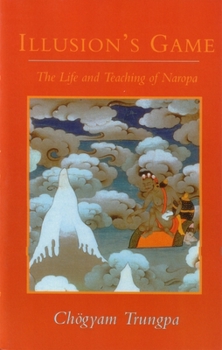Illusion's Game: The Life and Teaching of Naropa
(Part of the Dharma Ocean Series)
Select Format
Select Condition 
Book Overview
In what he calls a "200 percent potent" teaching, Ch gyam Trungpa reveals how the spiritual path is a raw and rugged "unlearning" process that draws us away from the comfort of conventional expectations and conceptual attitudes toward a naked encounter with reality. The tantric paradigm for this process is the story of the Indian master Naropa (1016-1100), who is among the enlightened teachers of the Kagyu lineage of the Tibetan Buddhism. Naropa was the leading scholar at Nalanda, the Buddhist monastic university, when he embarked upon the lonely and arduous path to enlightenment. After a series of daunting trials, he was prepared to receive the direct transmission of the awakened state of mind from his guru, Tilopa. Teachings that he received, including those known as the six doctrines of Naropa, have been passed down in the lineages of Tibetan Buddhism for a millennium. Trungpa's commentary shows the relevance of Naropa's extraordinary journey for today's practitioners who seek to follow the spiritual path. Naropa's story makes it possible to delineate in very concrete terms the various levels of spiritual development that lead to the student's readiness to meet the teacher's mind. Trungpa thus opens to Western students of Buddhism the path of devotion and surrender to the guru as the embodiment and representative of reality.
Format:Paperback
Language:English
ISBN:0877738572
ISBN13:9780877738572
Release Date:June 1994
Publisher:Shambhala
Length:192 Pages
Weight:0.60 lbs.
Dimensions:0.5" x 5.6" x 8.6"
Customer Reviews
2 ratings
Dense with information
Published by Thriftbooks.com User , 17 years ago
This book is densely packed with thought-provoking discussion. I have been studying it part-time for about two years and have not even finished it once. I keep re-starting to get a better grasp of what's being discussed. I plan to keep re-reading it over and over in order to to get a grasp of what they're talking about -- but that's a good thing. I highly recommend this book, but I believe you'll need to take it very seriously; this is not fluffy subject matter.
The most touching of Chogyam Trungpa's books
Published by Thriftbooks.com User , 21 years ago
Naropa thought he knew everything about Buddhism, having studied at the best Buddhist school on Earth. But he allowed himself to begin following his intuition, which led him to the realization that scholarly learning is not the heart of buddhism. In following Tilopa in Tibet, he had many trials and much suffering, many losses, which helped him lose his self-importance, the main obstacle to buddha nature. This has meaning for us today. We always wish there was less suffering. More popular Buddhist books now seem to teach that suffering can be avoided. Naropa did not avoid, but embraced the meaning inherent in the suffering, practiced vulnerability rather than protection, and as a result, came to understand his true nature. Not only an excellent teaching, but a fascinating story, a real page-turner.





